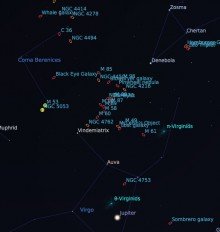April is a fantastic month for stargazing the in the UK: It still gets dark relatively early, and the nights aren’t as cold as they were only a couple of weeks before. For me, though, the real highlights of the night sky in April are the constellations of Virgo and Coma Berenices. By 10pm both constellations are in full view, high in the southeast, and contain probably the densest population of low magnitude galaxies anywhere in the sky. By low magnitude I mean that they’re bright, visible in small to medium aperture telescopes, and even at fairly low magnifications. Even 10×50 binoculars will pick up a few galaxies in the area, but 15x70s or 20x80s will show many more.
For me, the best starting point when exploring this area is to start at Denebola, the tail end of Leo. Imagine a line extending from there to Vindemiatrix, the upper left star of the ‘bowl’ of Virgo. The greatest density of galaxies can be found along that line, and extending above it into Coma Berenices, and down into the bowl of Virgo. There are 15 Messier galaxies alone in this area, including the giant ellipticals M84, 86 and 87, four Caldwell galaxies, and dozens of NGC galaxies. Something for everyone, regardless of equipment used.
A number of the galaxies along our line between Leo and Virgo form part of Markarian’s Chain, named after Armenian astronomer Benjamin Markarian who discovered that the galaxies in the chain shared a common motion. This is a fantastic sight, requiring low magnification to fit it all in (around 30-50 times will do it) and as wide a field of view as you can manage.
Coma Berenices contains one of my favourites: the Black Eye galaxy (M64) – so called because a large crescent of dark dust lies across the foreground, giving it the appearance of having a black eye. Four to five inch reflectors should be up to the job of spotting it. Staying with Coma Berenices, which is a fairly dim constellation, to the left of the lower star (Diadem) lies M53, a lovely globular cluster around 58,000 light years from earth. It contains over 250,000 stars, and is one of the furthest globulars from the center of our Galaxy. NGC 5053, another, but much dimmer, globular cluster, lies just below and to the left of M53, and will require a dark clear night and decent aperture to see it.
Jupiter currently lies in the lower part of Virgo, was at opposition on April 7, and is a fantastic sight right now. I’ve had several viewings of the gas giant recently, including a good look at the Great Red Spot, and can definitely say that it’s not to be missed!
To the right of Jupiter lies another one of my favourites: M104, the amazing Sombrero galaxy. At mag 9, it should just be visible in 10x50s, though I have to confess I haven’t tried. However, it should be visible at magnifications of 20x and up. Around 30 million light years away, it has a diameter of approximately 50,000 light years. When you see something that appears so small, and realise that it takes light to travel 50,000 years across it … well, it’s at times like that when you realise how big space is …
What’s up?
All the above, plus Mercury is very low in the west in the evenings, just after sunset, and Venus is low in the east just before sunrise. Jupiter is the only other easy planet on view at the moment.
The moon is currently waxing, and will be full on the 11th. Last quarter on the 19th, and the next new Moon is on the 26th.
There are two binocular-viewable comets around at the moment. C41P Tuttle-Giacobini-Kresak is currently in Draco (to the left of the Big Dipper), and appears as a bright fuzzy core, with a dimmer hazy halo around it. I’ve seen this several times recently, including when the moon was at first quarter, but I’d recommend waiting for darker skies. Comet C/2017 E4 Lovejoy is of a similar brightness, but can be found to the East, just before sunrise.
Clear skies!
Kevin Quinn is an amateur astronomer living in Piddletrenthide, is the proud owner of a ten-inch reflector, a small refractor, a case of eyepieces, and a couple of pairs of binoculars, tweets via @CerneAstro, and blogs (occasionally) via theastroguy.wordpress.com.
©Kevin Quinn







